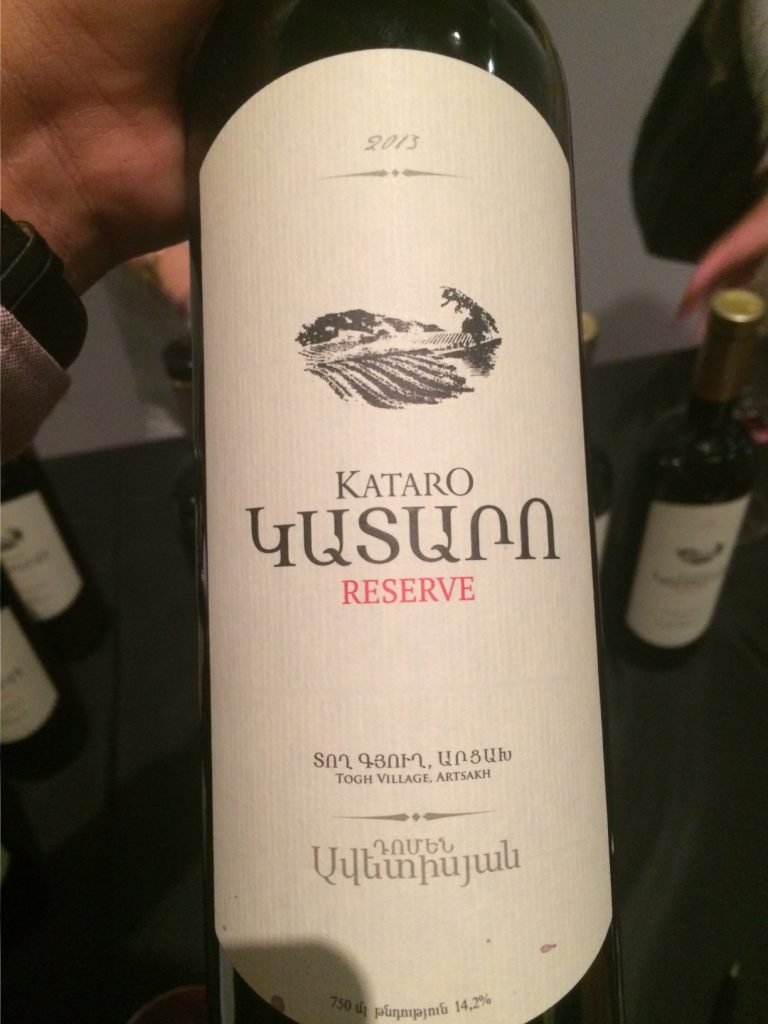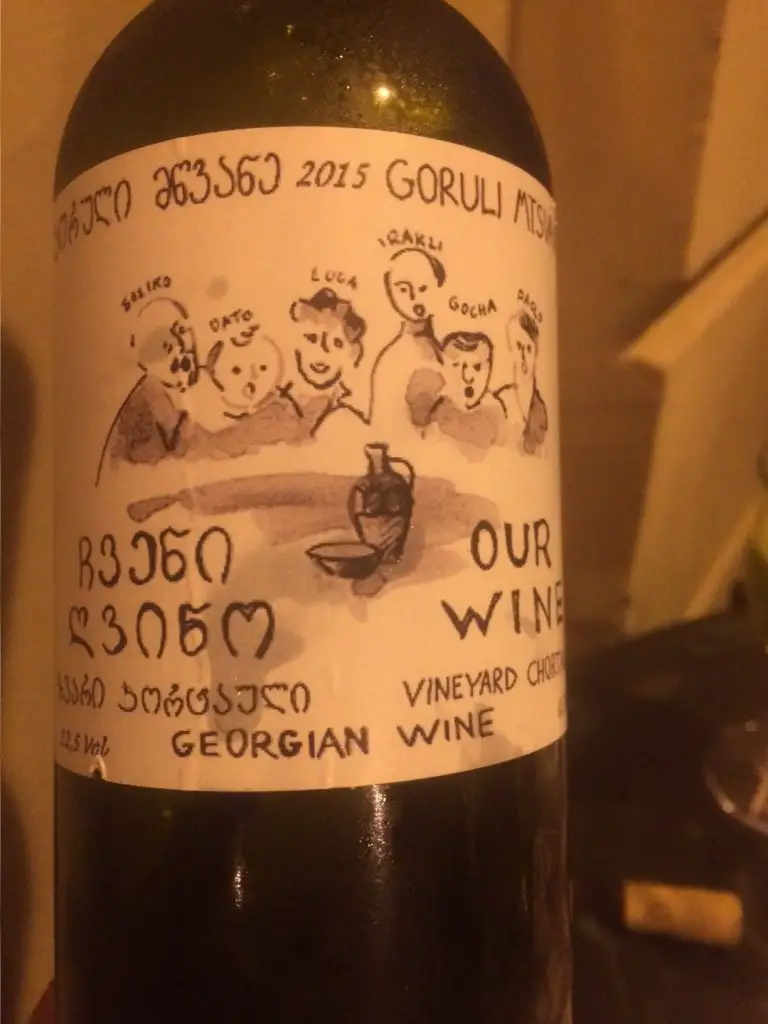Ancient Wine Grape Varieties from Armenia, Georgia, and Turkey
Reading Time: [est_time] Part of this article was originally published on Wine Folly. This article has been repurposed with their permission. This version of the article includes wine recommendations. The writing is done by Exotic Wine
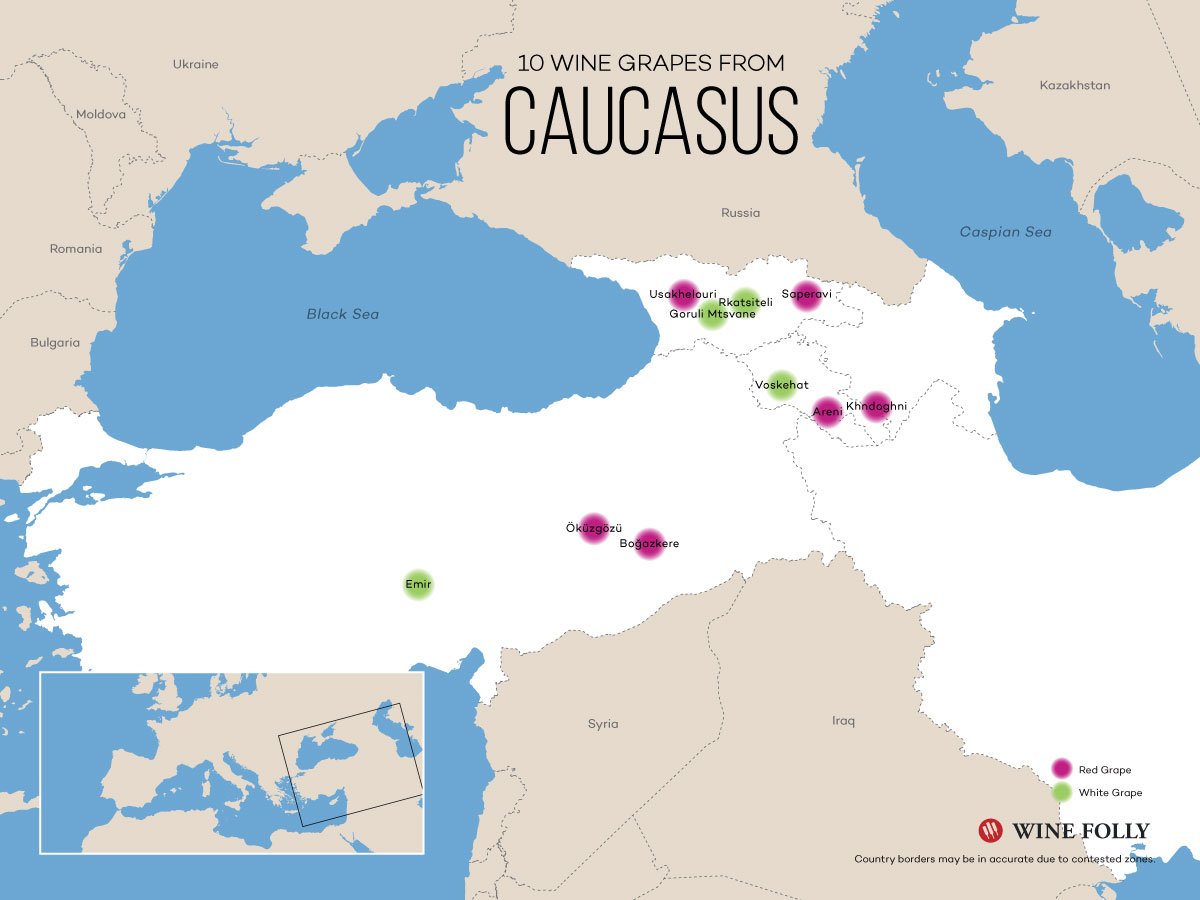
Reading Time: 5 minutes
Part of this article was originally published on Wine Folly. This article has been repurposed with their permission. This version of the article includes wine recommendations. The writing is done by Exotic Wine Travel and all images are produced by Wine Folly.
Somewhere in what is today’s Transcaucasia, mankind planted a new chapter in history. There’s more to wine than Old World and New World; welcome to the Ancient World of wine.
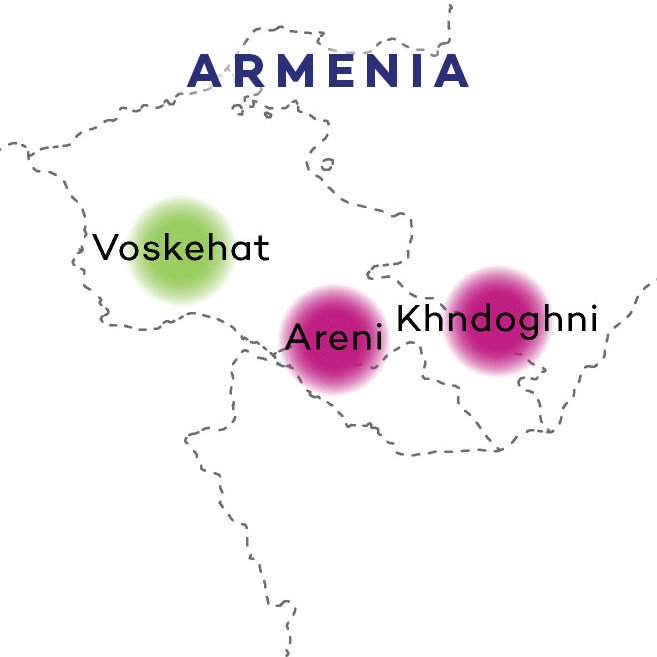
Areni
“ah-reh-nee”
This red grape hails from a town of the same name in south Armenia. Its thick skin protects it from the summer sun and the harsh, high-elevation, continental climate. It makes red wine with medium ruby hue, fresh acidity, and soft tannins. Wines made from this grape can have sour cherry, herb, spice, and grassy flavors–which, at times, remind us of a cross between Pinot Noir and Sangiovese. The grape gained some international fame when Zorah Karasi, a varietal wine made from Areni, was featured in the list of Bloomberg’s Top Ten Wines of 2012.
Khndoghni
“khhhung-douh-nee”
The name Khndoghni is derived from the Armenian word “khind”, which means laughter. This is a native red wine variety from the controversial Nagorno-Karabakh area, which–depending on the source–is considered a region of Armenia, a separate nation, or a part of Azerbaijan. This grape has high tannins and offers interesting characteristics of black and blue fruits, cotton candy, and earth. Wines made from this grape have grippy tannins, precise structure, and exhibit aging potential. Khndoghni is usually aged in Caucasian oak barrels that are sourced from the same area.
Voskehat
“voh-ski-hut”
If Areni is the signature red grape of Armenia, then Voskehat is the poster child of Armenian white wine. Voskehat translates to “golden seed”. It is a hardy and thick-skinned grape that gets along well with the hot summer and bitterly cold winter of the high Armenian Plateau. Almost all the winemakers in Armenia who make a white wine use this grape, either in varietal wine form or in a blend. It makes smooth- and medium-bodied white wine with floral, savory, tropical fruit, and stone fruit notes. We have a recommendation for a Voskehat varietal wine in Voskevaz: A New Face in the Armenian Wine Scene.
Exotic Wine Travel’s Choice: Kataro Reserve 2013
A true product of Nagorno-Karabakh, also known as Artsakh. This wine is made from an indigenous variety called Khndoghni and is aged in local oak sourced from the same area. A dark, rich, and massively structured wine. It is more of an earthy (than fruity) wine with other flavors of black fruit, chocolate, and smoke. A unique and well-made wine; it has the stuffing to age very well and can be paired wonderfully with Khorovats (Armenian barbecue).
********************
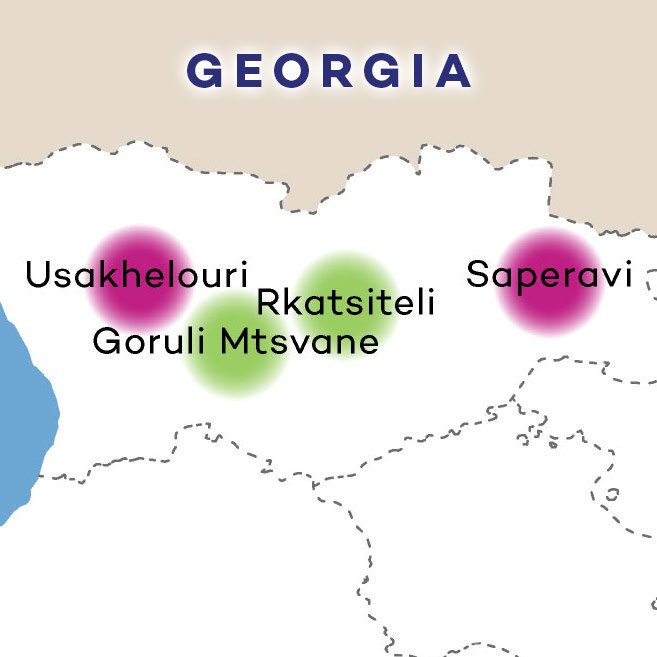
Goruli Mtsvane
“go-roo-lee mahts-vah-nay”
This is a different variety from Mtsvane, which grows in almost every region in Georgia. Goruli Mtsvane means “green from Gori”, and Gori is a city in south-central Georgia. A late-ripening grape that oxidizes easily, only a few winemakers make wine from this rare variety. When made in the qvevri, it delivers one of the most interesting experiences in wine. Its high-toned aromas range from peach, lime, apricot, wildflower, pine, and nut. On the palate, the weighty body is reminiscent of a light red wine.
Rkatsiteli
“rah-kats-ee-teh-lee”
Rkatsiteli, whose name means “red stem,” is a ubiquitous white wine variety that comprises nearly half of Georgia’s vineyard plantings. It is a hardy and easy-to-grow grape as it is resistant to cold and maintains a high level of acidity and sugar as it ripens. It can be made into dry, semi-sweet, and fortified wines, and also brandy. This variety is treated in both the traditional Georgian qvevri-style with extended skin contact and conventional-style white wine technique. In the conventional style, it becomes a well-balanced, medium-bodied white wine with a touch of spice. When made in qvevri style, it takes on an amber tone, a forceful structure, and beautiful creaminess on the palate. What Chardonnay is for California, this grape is to Georgia. Check out Exotic Wine Travel’s 16 Wines Of 2016 for the tasting notes on Okro’s Wine Rkatsiteli 2010.
Saperavi
“sah-per-ra-vee “
Saperavi means “color/dye.” This is the most widely planted red wine variety in Georgia. Like Alicante Bouschet, it is teinturier with red flesh and red juice. This dark-skinned and dark-fleshed grape makes deep red, inky, and often opaque wine with heavy body and profound texture. Some wineries in the country label it as black wine instead of red. Due to the grape’s marked acidity and myriad characteristics of black fruit, licorice, chocolate, earth, smoked meat, tobacco, savory spice, and pepper, it is extremely versatile and can be made into rosé, dry, semi-sweet, sweet, and fortified wines. A dry red Saperavi wine resembles a mix between Blaufrankisch and Syrah. Check out our tasting notes for Artizani Saperavi, Lagvinari Saperavi, and Jakeli Saperavi.
Also, here’s an episode of Exotic Wine Travel where we tasted two of our favorite Saperavi wines, Khareba Saperavi Premium Gold 2010 and Kortavebis Marani Saperavi 2014, side by side.
Usakhelouri
“oosa-hello-oory”
Usakhelouri translates to “a grape with no name.” A native of western Georgia, this is an extremely low-yielding and rare variety that grows on the slopes of the Greater Caucasus Mountains. The total annual harvest is only a few tons. It is grown in a few small, remote villages and can be made into dry red or naturally semi-sweet wine with a high price tag. The wines made from this variety are aromatic and velvety, with vibrant acidity and light tannins. The flavors are red fruit, purple flower, mint, pepper, and forest floor. The semi-sweet wine made from Usakhelouri is a wonderfully complex wine that somehow reminds us of what Pinot Noir might taste like if it were made into a dessert wine.
Exotic Wine Travel’s Choice: Soliko Our Wine Goruli Mtsvane 2015
Made from the rare grape variety Goruli Mtsvane, this wine is fermented, macerated, and aged in traditional Georgian qvevri. The wine has flavors of orange peel, peach concentrate, and wild flowers, perked up by a slight tug from the tannins. A food-friendly, juicy wine.
********************
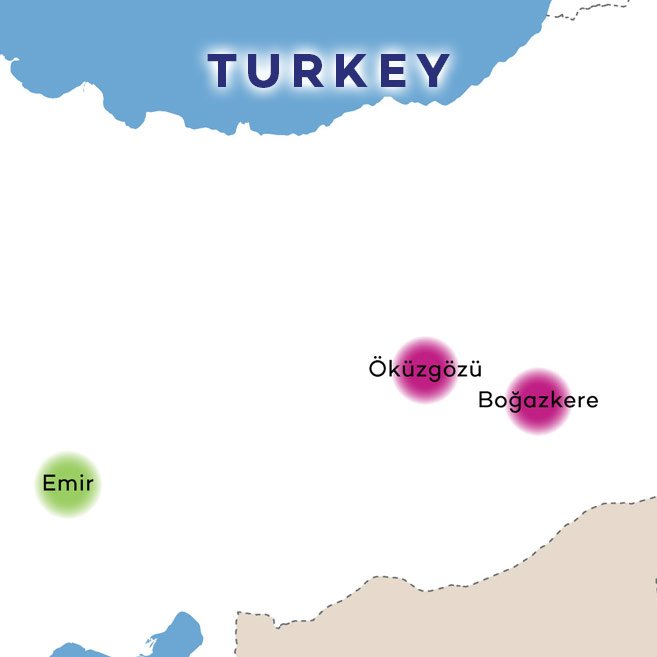
Boğazkere
“bow-ahz-keh-reh”
This grape is native to the Diyarbakir area in Southeast Turkey. It prefers to grow in a hot, dry climate, at high altitude. The name Boğazkere translates to “throat burner” – a possible reference to its strong tannins and medium acidity, which is reminiscent of Tannat. Boğazkere can be used as a blending grape and can also be made into a varietal wine. In varietal wine, it expresses notes of dark berry, pepper, dark chocolate, clove, eucalyptus, tobacco, and licorice. In our interview with Turkish wine maestro Burcak Desombre, she recommends the Kavaklidere Prestige as a fine example of this variety.
Emir
“eh-meer”
Native to and grown exclusively in the famous Cappadocia region of Turkey, this grape thrives in high altitude, volcanic soil, and diurnal temperature variation (hot during the day and cool at night). Its name translates to “lord/ruler,” as the wine made from Emir was once a popular choice at the local lords’ tables. It produces a smooth and crisp white wine with yellow-green hue. The flavor profile includes apple, yellow pear, pineapple, blood orange, kiwi, melon, and a touch of pine. Emir is often compared to Albarino and Pinot Grigio; while Sarah Abbot MW describes it as “a bit like Manseng but with more aromatics”.
Öküzgözü
“ur-kuz-gur-zuh”
This grape is native to the Elazig area in Eastern Turkey. It likes hot, dry summers, and cold winters, which matches up perfectly with the extreme continental climate of the Anatolian Plateau. The name means “ox eye,” which hints at its round and fleshy appearance. Öküzgözü has high acidity and floral aromas. On the palate, it leans towards raspberry, plum, pomegranate, brown spice, and earthy flavors. The high acidity is what stands out the most in this grape. It is often blended with Boğazkere for added structure. On its own, it makes some memorable, fruit-forward wines.
Exotic Wine Travel’s Choice: Kayra, Buzbag Bölge Serisi Elazig, Öküzgözü, 2012
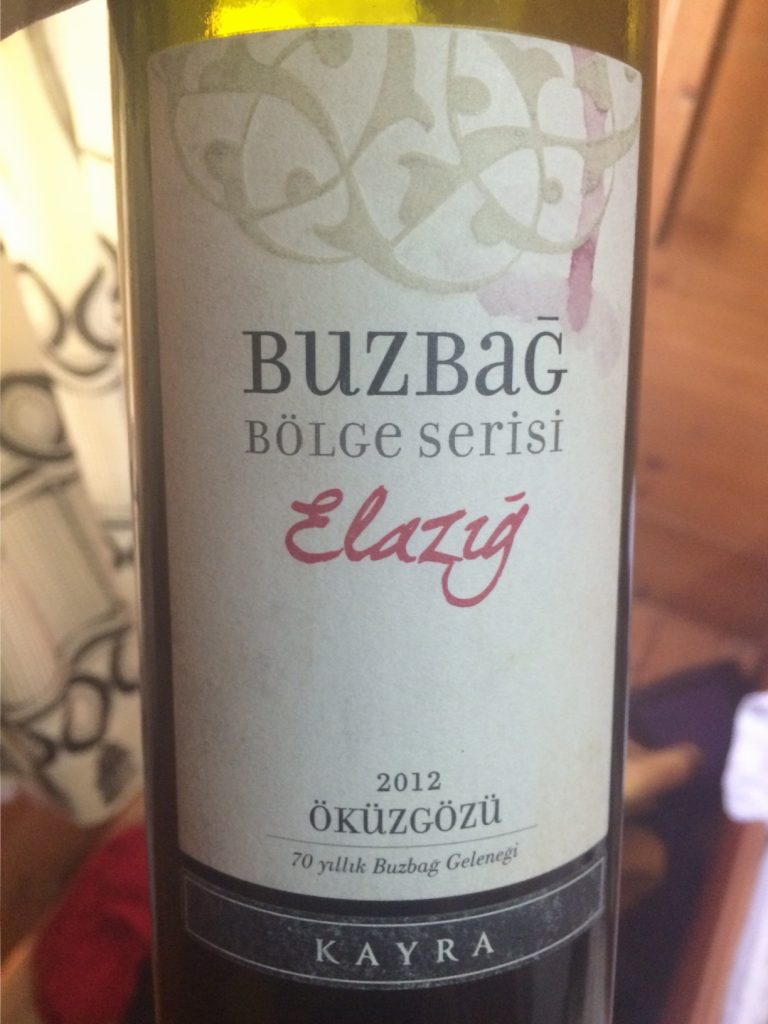
This is a juicy, balanced, and delicious Turkish wine made from the indigenous variety Öküzgözü. If you are looking for a red wine that’s bright, fruity and without pretense, then this is a wine for you. This is produced by a big producer called Kayra who has many vineyards in eastern Turkey. The flavors are of sour cherry, fruit punch, and earth, with nice tanginess and smooth tannins. It goes extremely well Turkish grilled meat dishes.
********************
For a listing of articles and videos on Armenian, Georgian, and Turkish wines and wine travel in the Caucasus Region, check out our page Uncorking the Caucasus. To purchase the Kindle or paperback copy of the book Uncorking the Caucasus: Wines from Turkey, Armenia, and Georgia, please head to this Amazon product page.
https://www.facebook.com/exowinetravel/videos/1091099150987466/
The ideas expressed in this article are personal opinions and are not associated with any sponsors or business promotions.


